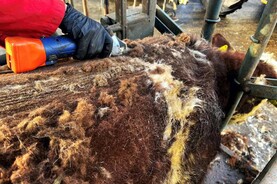Keep a close eye on maiden and in-calf heifers at grass as fly levels increase, bringing with it a greater chance of summer mastitis.
Higher temperatures and rain showers this week provide ideal conditions for flies, with activity levels most noticeable around hedgerows and trees.
Cattle tend to congregate in such areas to shelter from heavy rain or look for shade during warm days.
Fly levels are also increased as dung congregates in these areas from cattle seeking shelter. Fields close to stagnant water courses are also prone to high fly activity.
At-risk animals
Maiden heifers and in-calf replacements set to calve in late summer and autumn are at most risk of summer mastitis.
Dry cows calving in late summer are also a high risk group.
That risk is increased when heifers are grazing lush grass, leading animals to pass loose dung that soils hindquarters and tails, attracting flies.
Flies carry bacterial infections and if they start congregating around the udder, they can transmit bacteria into the teat canal, causing swelling.
Affected cattle are also prone to being dull, stiff when walking and often become isolated from other animals.
Action
There are steps that can be taken to control flies, such as applying insecticide pour-on products regularly.
Other options include garlic licks, clipping tails to improve cleanliness, insect repellent ear tags and avoid grazing higher-risk animals in sheltered fields where flies are common.
Read more
Five areas to focus on farm safety
Martbids Database: store trade takes a turn
Keep a close eye on maiden and in-calf heifers at grass as fly levels increase, bringing with it a greater chance of summer mastitis.
Higher temperatures and rain showers this week provide ideal conditions for flies, with activity levels most noticeable around hedgerows and trees.
Cattle tend to congregate in such areas to shelter from heavy rain or look for shade during warm days.
Fly levels are also increased as dung congregates in these areas from cattle seeking shelter. Fields close to stagnant water courses are also prone to high fly activity.
At-risk animals
Maiden heifers and in-calf replacements set to calve in late summer and autumn are at most risk of summer mastitis.
Dry cows calving in late summer are also a high risk group.
That risk is increased when heifers are grazing lush grass, leading animals to pass loose dung that soils hindquarters and tails, attracting flies.
Flies carry bacterial infections and if they start congregating around the udder, they can transmit bacteria into the teat canal, causing swelling.
Affected cattle are also prone to being dull, stiff when walking and often become isolated from other animals.
Action
There are steps that can be taken to control flies, such as applying insecticide pour-on products regularly.
Other options include garlic licks, clipping tails to improve cleanliness, insect repellent ear tags and avoid grazing higher-risk animals in sheltered fields where flies are common.
Read more
Five areas to focus on farm safety
Martbids Database: store trade takes a turn






 This is a subscriber-only article
This is a subscriber-only article










SHARING OPTIONS: